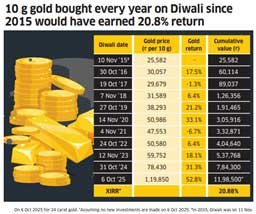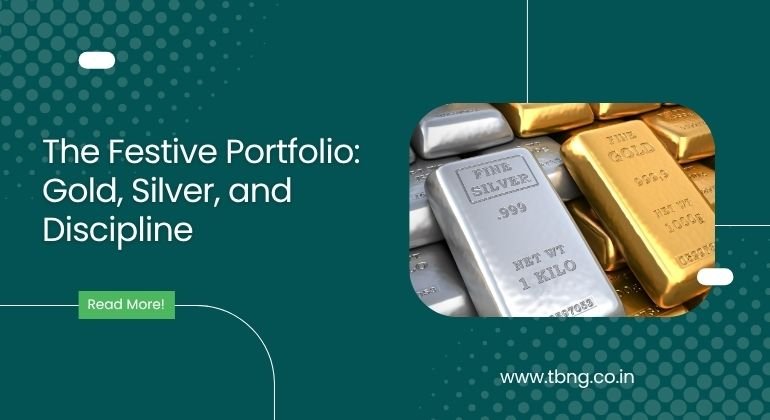Last Diwali, we painted gold as both a guardian and a quiet engine of wealth. Twelve months later, the questions persist: Does gold still serve that dual role? And in a year where silver is stealing headlines, should it occupy a tactical corner of a serious portfolio?
For investors who think in decades, not short-term fluctuations, it’s less about returns and more about building long-term positions, respecting the cycles we are in and also sticking to the sell disciplines based on the asset allocation. It’s about preserving purchasing power, maintaining flexibility, and ensuring every allocation decision reflects a long-term philosophy rather than a short-term impulse.
A Year Ago: Gold’s Resurgence

In 2024, gold reminded everyone why it remains a pillar of prudent portfolios. ET Markets reported that gold delivered nearly 28% returns that year, drawing renewed interest from long-term players. At the same time, data from ET Wealth showed that investors who bought 10 grams of gold each Diwali since 2015 have enjoyed approximate returns of over 20% annually, a compelling reframing of the “annual ritual” as a de-risked accumulation strategy. But the narrative was always more than just gains. Gold offers inflation buffer, currency hedging and portfolio ballast, benefits that become visible precisely when macro stress arrives.
What’s Changing Now:Discipline Over Momentum
Gold prices have continued to reach new highs. But rather than fuelling zeal, recent behaviour suggests measured allocation. Gold ETFs in India recorded their largest net inflow ever in September 2025, ₹8,363 crore, pushing AUM to new highs. Globally, gold ETF holdings in India alone have risen nearly 42% year-on-year, reaching about 66.7 tonnes (AUM up 88%). These data points show sustained investor confidence but also a shift: more flows are going into regulated, transparent instruments rather than physical ones alone. The tone is quieter, less speculative. More structural allocation, less chase.
How Disciplined Portfolios Treat Gold
In conversations with long-horizon investors and families that have built wealth across cycles, certainpatterns repeat. We’ve phrased this not as a prescription, but as observed discipline:
● Gold earns its seat, it doesn’t fight for one. Rather than being the centrepiece, gold is one of the stable supports in a broader framework.
● Regular increments over lump sums. Even when gold is strong, deployment is staggered, smoothing entry risk rather than trying to catch the peak.
● Periodic pruning. When today’s strength causes gold to exceed its target weight, modest trims help maintain balance.
● Complement, not compete. Gold is viewed not as an alternative to equity or private investments, but as a stabiliser when volatility tests resolve.
These observed practices mirror what many family offices and ultra-affluent investors do. According to ETFGI, over 31% of gold ETF assets in India are held by High Net Worth and corporate portfolios. The conclusion, however, is not that well-managed portfolios always have a significant allocation to gold in them; rather, they see it as a practice in balance and patience rather than aggression.
A Word on Silver — The Tactical Element
Silver is enjoying its moment. The price recently pierced $50 per ounce, triggering headlines and investor curiosity. But here’s where nuance matters: many Silver ETFs are trading at elevated premiums because underlying physical silver is harder to source. ETF market makers that should deliver silver bars in exchange for units are finding few sellers. This supply–demand mismatch pushes ETF prices above their intrinsic fair value, a distortion to watch. Several mutual fund houses (Kotak, SBI, UTI) have temporarily halted new lump-sum investments in silver ETFs to prevent overexposure to premium risk. Given this, silver can be folded into a portfolio, but only in modest, tactical doses. A small, staggered allocation, entered with patience and under constant observation, makes more sense than committing large sums at the peak of enthusiasm.
What an Informed Next Move Looks Like
● Let gold continue anchoring your non-equity side. It’s not the engine but the shock absorber.
● Use staged entries, periodic, measured buying helps neutralise timing risk.
● Watch weights; if gold or silver slightly overshoot target bands, use that as an opportunity to rebalance.
● Treat silver as optional seasoning, not the main entrée. Avoid aggressiveness in silver, which can displace conviction in your core strategy.
● Maintain conviction when others pivot. Markets will always draw guest appearances by surprises; long-term portfolios are built by resisting reflex.

